In this image provided by the Imperial War Museum, World War I German and British soldiers stand together on the battlefield near Ploegsteert, Belgium during Dec. 1914. Soldiers who had been killing each other by the tens of thousands for months climbed out of their soggy trenches to seek a shred of humanity amid the horrors of World War I. Hands reached out across the divide and in Flanders Fields a century ago, a spontaneous Christmas truce ever so briefly lifted the human spirit. (AP Photo/IWM, Q11718)
The Associated Press
PLOEGSTEERT, Belgium (AP) - With British and German forces separated only by a no-man's land littered with fallen comrades, sounds of a German Christmas carol suddenly drifted across the frigid air: "Stille Nacht, Heilige Nacht" ("Silent Night, Holy Night").
Then, during that first Christmas Day in World War I, something magical happened.
Soldiers who had been killing each other by the tens of thousands for months climbed out of their soggy, muddy trenches to seek a shred of humanity amid the horrors of war.
Hands reached out across the narrow divide, presents were exchanged, and in Flanders Fields a century ago, a spontaneous Christmas truce briefly lifted the human spirit.
"Not a shot was fired," Lt. Kurt Zehmisch of the 134th Saxony regiment wrote with amazement in his diary that Christmas.
On the other side of the front line, Pvt. Henry Williamson of the London Rifle Brigade was amazed by the goodwill among his enemies. "Yes, all day Xmas Day & as I write. Marvelous, isn't it?"
Few could be believe their eyes, especially on this mud-caked patch of Belgium and northern France where crimson poppies had long ago shriveled in the cold.
Peace allowed for corpses to be recovered from the fields and given a proper burial. Fighting continued in many other places on the front line. But it was a momentary peace in a war that would last for nearly four more years.
___
THE BIRDCAGE
Near one of the spots where British and German soldiers fraternized for the unexpected truce, a dark, dirt track veers off the road and meanders into the gloom of the woods.
There, a cleared space has the graves of British soldiers who died on Dec. 19, 1914, in a battle as gruesome as it was insignificant, their dreams of a peaceful Christmas ignored and buried in the cold mud.
It was a time when swift military movement from Germany across France to the Belgian coast was grinding to a stalemate, leaving hundreds of thousands of casualties behind. For both sides - Germany versus an alliance led by France and Britain - this buried any hope that the war would be over by Christmas.
The result was a form of warfare across trenches where human life was expendable.
"There are a number of local attacks which never make it into the history books, but which all cause a great loss among the troops," said Piet Chielens, curator at the In Flanders' Fields Museum in Ypres, Belgium.
The Dec. 19, 1914 "Birdcage" attack occurred on a bulge of the German line about the size of a football (soccer) field. Allied soldiers also had been thinking about Christmas, but for 80 of them it turned into disaster in an area where a warren of barbed wire had given the German defenders a huge advantage.
Chielens said that during those early days of the war both sides dug into the Flemish soil, with commanders "attacking without deep thought, without deep concern about the fate of their men." The infamous "Birdcage" was one of those battles that made them realize that strategy wouldn't work.
With offensive artillery nearly non-existent and sometimes so wayward that it also was a threat to its own troops, soldiers were thrown into action where one machine gun could mow down a whole row of approaching men.
Some of the bodies found after the attack were so mangled they could no longer be told apart, and today the headstones of several casualties stand shoulder to shoulder to mark that horror.
___
"WE NO SHOOT"
Little wonder so many soldiers were pining for a glimmer of hope on Christmas Eve.
Frank and Maurice Wray of the London Rifle Brigade settled in to keep watch when they suddenly heard a German band in the trenches play songs "common to both nations," they later wrote in an article. "Quite understandably a wave of nostalgia passed over us."
At dawn, a German called out, "We good. We no shoot," and the Wrays noted: "And so was born an unofficial armistice." Men walked out, extremely apprehensive at first, many fearing some deadly trick. Then human warmth cracked the freezing cold.
Chielens said that similar scenes occurred at about 30 scattered points across many miles (kilometers) of Belgium. Others happened across the Western Front, which ran from the North Sea to the Swiss border.
Apart from talk in a shared language or merely with hands and kindred eyes, the men exchanged gifts, using everything from bully beef and barrels of beer to small mementos. Some played football.
German soldier Werner Keil scribbled his name on a piece of paper and gave a uniform button to 19-year-old British Cpl. Eric Rowden of the Queen's Westminster Rifles on Christmas Day 1914. "We laughed and joked together, having forgotten war altogether," Rowden wrote.
War, though, was never far away, including memories of the Birdcage still lingered and the burials of dead soldiers. It was hardly as if gunfire stopped all over to make room for warm embraces.
On the Belgian stretch around Ploegsteert alone, "we still have over 250 people dying on Christmas Day itself. There was enough fighting going on," Chielens said.
Despite the uplifting moment, commanders away from the trenches abhorred the softening of posture and fighting spirit. Cpt. Robert Hamilton of Britain's 1st battalion Royal Warwickshire noted: "I am told the general and staff are furious - but powerless to stop it."
____
25TH DECEMBER 1917
All that would change soon enough, and the 1914 truce would not be repeated.
Once British Gen. Sir Horace Smith-Dorrien had heard of it on Dec. 27, 1914, he wrote in a confidential memorandum that "this is only illustrative of the apathetic state we are gradually sinking into." He threatened disciplinary action to avoid a repeat.
"It was certainly remembered by the army commands because around Christmas in 1915, 1916, 1917, they see to it that there is no such thing as a truce possible because then the shelling will be deliberate and very intensive."
One thing did continue - the relentless killing.
Next to a monument in Ploegsteert to mark football playing at Christmas is the Prowse Point Military cemetery. Amid the 225 dead, three headstones from the 27th Battalion Australian infantry stand out.
Date of death? "25th December 1917."
___
Virginia Mayo contributed to this article.
___
Raf Casert can be followed on Twitter at http://www.twitter.com/rcasert
In this photo taken on Nov. 21, 2014, a Princess Mary Christmas tin from 1914 on display at the Plugstreet 14-18 Experience museum in Ploegsteert, Belgium. The gift boxes were given to soldiers during Christmas of 1914. The tins contained a package of cigarettes, a Christmas card and a photo of Princess Mary. Soldiers who had been killing each other by the tens of thousands for months climbed out of their soggy trenches to seek a shred of humanity amid the horrors of World War I. Hands reached out across the divide and in Flanders Fields a century ago, a spontaneous Christmas truce ever so briefly lifted the human spirit. (AP Photo/Virginia Mayo)
The Associated Press

In this undated image provided by the Henry Williamson Society, World War I soldier Private Henry Williamson poses in his uniform. Williamson, served with the London Rifle Brigade in Ploegsteert, Belgium during December of 1914 and sent a letter home to his mother detailing his life in the trenches and outlining events during the Christmas Truce. (AP Photo/Henry Williamson Society)
The Associated Press
In this image provided by the Henry Williamson Society, a letter from World War I soldier Private Henry Williamson to his mother dated Dec. 26, 1914. Williamson, served with the London Rifle Brigade in Ploegsteert, Belgium during December of 1914 and sent a letter home to his mother detailing his life in the trenches and outlining events during the Christmas Truce. (AP Photo/Henry Williamson Society)
The Associated Press
In this undated image provided by the Dorset History Centre, World War I Regimental Sergeant Major George Beck poses in his uniform. Beck served with the Royal Warwickshire Regiment and kept a diary of his time in the trenches, including several major battles, the Christmas Truce and the first use of gas in 1915. (AP Photo/Dorset History Centre)
The Associated Press
In this undated image provided by the Dorset History Centre, a diary entry from Christmas 1914 by World War I Regimental Sergeant Major George Beck. Beck served with the Royal Warwickshire Regiment and kept a diary of his time in the trenches, including several major battles, the Christmas Truce and the first use of gas in 1915. Becks diary outlines a battle fought near Ploegsteert in an area commonly referred to as "the Birdcage", it also goes on to refer to the Christmas Truce with an entry that reads "German soldiers intermingled and exchanged souvenirs." (AP Photo/Dorset History Centre)
The Associated Press
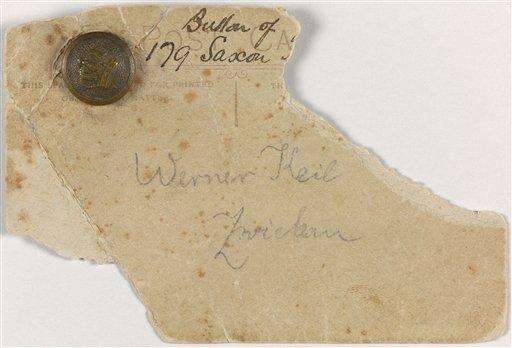
In this photo provided by the Imperial War Museum, a button from World War I German soldier Werner Keil which was given to 19-year-old British Corporal Eric Rowden of the Queenâs Westminster Rifles on Christmas Day 1914. In his diary, Rowden wrote, "I went out and found a German who spoke English a little and we exchanged buttons and cigarettes and I had 2 or 3 cigars given me and we laughed and joked together, having forgotten war altogether". Many diaries and letters from World War I soldiers have come to light in the recent years which describe a lull in the fighting during Christmas 1914 along an approximately 500 mile stretch of front line from Belgium stretching to the Swiss border. (AP Photo/IWM)
The Associated Press
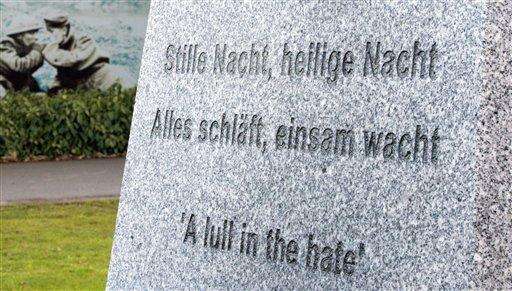
In this photo taken on Saturday, Dec. 6, 2014, the words "A lull in the hate" are inscribed on a Christmas Truce monument recently inaugurated in Messines, Belgium. Messines is one of the few sites along a nearly 500 mile Western Front where World War I soldiers from opposing sides are reported to have engaged in a friendly truce for a short period of time around the Christmas period in 1914. (AP Photo/Virginia Mayo)
The Associated Press
In this file photo from Dec. 18, 2013, a scarecrow with a Santa Claus hat is in a field near what would have been a World War I "No Man's Land" near Messines, Belgium. The site is one of the few along a nearly 500 mile Western Front where World War I soldiers from opposing sides are reported to have engaged in a friendly truce for a short period of time at Christmas in 1914. (AP Photo/Virginia Mayo, File)
The Associated Press
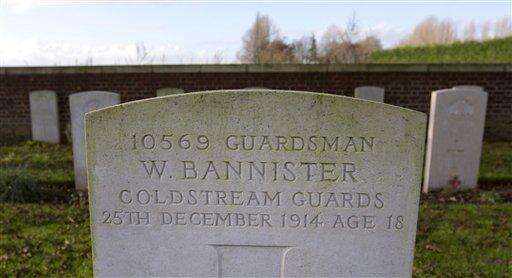
In this photo taken on Saturday, Dec. 6, 2014, the grave of World War I soldier W. Bannister at Le Touret Cemetery in Richebourg, France. Bannister, who served with the Coldstream Guards was killed on Christmas Day in 1914. While reports of enemies laying down their arms and engaging in friendly discourse during the Christmas period in 1914 are widely reported through diaries and letters of the period, there were also numerous casualties, many were soldiers who were relieving troops on the front line or resupplying the lines. (AP Photo/Virginia Mayo)
The Associated Press
In this photo taken on Friday, Nov. 21, 2014, a bunker known as the Charing Cross Advance Dressing station in a field on the edge of Ploegsteert Wood in Ploegsteert, Belgium. The bunker later became instrumental in the fight for the Messines Ridge which was fought over bitterly the entire four years of the war. (AP Photo/Virginia Mayo)
The Associated Press
In this photo taken on Thursday, Dec. 11, 2014, tire marks run through a field between farmhouses in an area known in World War I as "the Birdcage" in Ploegsteert, Belgium. The Birdcage was a sprawling complex of defensive trenches just on the edge of Ploegsteert Wood. The site was the scene of major fighting in Dec. 1914 with attacks led by the London Rifle Brigade and the Somerset Light Infantry. (AP Photo/Virginia Mayo)
The Associated Press
In this photo taken on Nov. 21, 2014, a red wreath of poppies is left on the top of the Christmas Truce monument in Frelinghien, France. Frelinghien was one of several sites along the then approximately 500 mile long Western Front in which fraternization was reported between opposing troops in World War I. (AP Photo/Virginia Mayo)
The Associated Press
In this photo taken on Thursday, Dec. 11, 2014, a cross marker and faded photo are placed where the body of World War I British soldier Harry Wilkinson was found in a sector known as "The Birdcage" in Ploegsteert, Belgium. Wilkinson served with the 2nd Battalion Lancashire Fusiliers and was killed in action on Nov. 10, 1914. His body was discovered in 1999 and he was reburied in 2001 at Prowse Point cemetery in Ploegsteert with full military honors. (AP Photo/Virginia Mayo)
The Associated Press
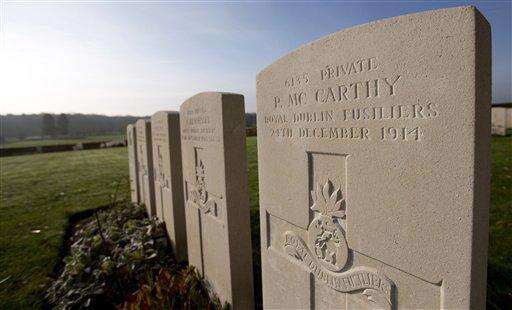
In this photo taken on Nov. 21, 2014, the grave of World War I soldier P. Mc Carthy at Prowse Point cemetery in Ploegsteert, Belgium. The cemetery contains the bodies of two soldiers, P. Mc Carthy and T. Delany, who served with the Royal Dublin Fusiliers and who both died on Christmas eve in 1914. While reports of enemies laying down their arms and engaging in friendly discourse during the Christmas period in 1914 are widely reported through diaries and letters of the period, there were also numerous casualties, many were soldiers who were relieving troops on the front line or resupplying the lines. (AP Photo/Virginia Mayo)
The Associated Press

In this photo taken on Saturday, Dec. 6, 2014, the Prowse Point World War I Commonwealth cemetery from the vantage point of Ploegsteert Wood in Ploegsteert, Belgium. Soldiers who had been killing each other by the tens of thousands for months climbed out of their soggy trenches in 1914 to seek a shred of humanity amid the horrors of World War I. Hands reached out across the divide and in Flanders Fields a century ago, a spontaneous Christmas truce ever so briefly lifted the human spirit. (AP Photo/Virginia Mayo)
The Associated Press

In this photo taken on Friday, Dec. 12, 2014, an illustration in the book "Bullets and Billets" of where soldiers met on Christmas Day 1914 drawn by World War I British soldier and cartoonist Bruce Bairnsfather on display at the In Flanders Fields Museum in Ypres, Belgium. Bairnsfather was known for his "Old Bill" cartoons, and even more famously for his account of the Christmas Truce at Ploegsteert, Belgium, where he reported that he traded a uniform button with a German soldier. (AP Photo/Virginia Mayo)
The Associated Press
In this Thursday, Dec 12, 2013 file photo, the World War I Ploegsteert Memorial in Ploegsteert, Belgium. The memorial commemorates more than 11,000 servicemen of the United Kingdom and South African forces who died in the sector during the First World War and have no known grave. (AP Photo/Virginia Mayo)
The Associated Press

In this photo taken on Thursday, Dec. 11, 2014, Andrew Hamilton holds up the diary of his grandfather, World War I British Captain Robert Hamilton who served with the Royal Warwickshire Regiment, in Ploegsteert, Belgium. Many diaries and letters from World War I soldiers have come to light in the recent years which describe a lull in the fighting during Christmas 1914 along an approximately 500 mile stretch of front line from Belgium stretching to the Swiss border. The entry for Christmas Day 1914 reads, "A day unique in the world's history. I met the officer and we arranged a local armistice for 48 hours. As far as I can gather, this effort of ours extended itself throughout the whole line. Soldiers on both sides met in their hundreds and exchanged greetings and gifts." (AP Photo/Virginia Mayo)
The Associated Press
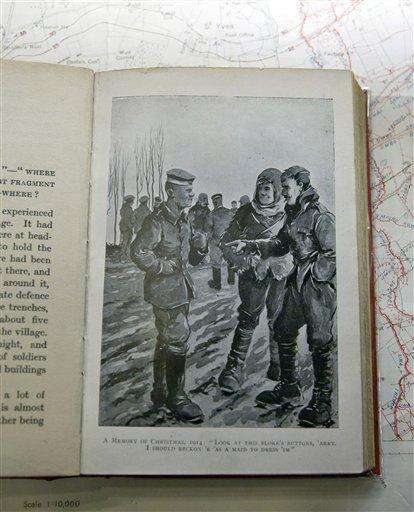
In this photo taken on Friday, Dec. 12, 2014, an illustration in the book "Bullets and Billets" of soldiers fraternizing on Christmas Day 1914 drawn by World War I British soldier and cartoonist Bruce Bairnsfather on display at the In Flanders Fields Museum in Ypres, Belgium. Bairnsfather was known for his "Old Bill" cartoons, and even more famously for his account of the Christmas Truce at Ploegsteert, Belgium, where he reported that he traded a uniform button with a German soldier. (AP Photo/Virginia Mayo)
The Associated Press

In this photograph taken on Dec. 12, 2014, a typed transcription of the Christmas day 1914 diary entry of German World War I soldier Lt. Kurt Zehmisch at the In Flanders Fields Museum in Ypres, Belgium. Diaries and letters from World War I soldiers have come to light in the recent years which describe a lull in the fighting during Christmas 1914 along an approximately 500 mile stretch of front line from Belgium to the Swiss border. Many soldiers reported trading items with their enemies and even engaging in a friendly kick about of a ball. A portion of the transcript from Kurt Zehmisch reads "It was all so wonderful and exceptional. That is what it looked like to the English officers too. So Christmas, the celebration of love, made sure that the hated enemies turned into friends for a short time. This Christmas will remain unforgetable." (AP Photo/Virginia Mayo)
The Associated Press
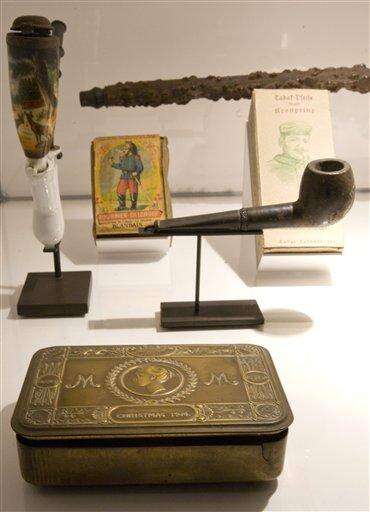
In this photo taken on Nov. 21, 2014, a Princess Mary Christmas tin from 1914 on display at the Plugstreet 14-18 Experience museum in Ploegsteert, Belgium. The gift boxes were given to soldiers during Christmas of 1914. The tins contained a package of cigarettes, a Christmas card and a photo of Princess Mary. Soldiers who had been killing each other by the tens of thousands for months climbed out of their soggy trenches to seek a shred of humanity amid the horrors of World War I. Hands reached out across the divide and in Flanders Fields a century ago, a spontaneous Christmas truce ever so briefly lifted the human spirit. (AP Photo/Virginia Mayo)
The Associated Press
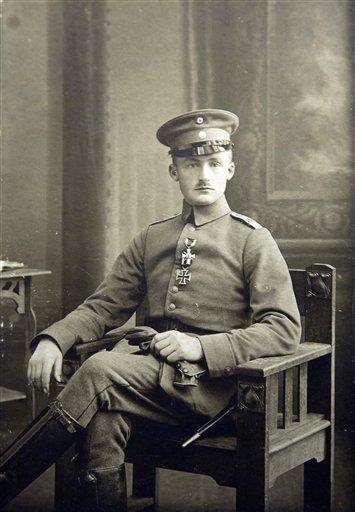
In this photo taken from an image in the collection at In Flanders Fields Museum provided by the family of German soldier Kurt Zehmisch, German World War I soldier Lt. Kurt Zehmisch poses for a photo in his uniform in an undated photograph. Diaries and letters from World War I soldiers have come to light in the recent years which describe a lull in the fighting during Christmas 1914 along an approximately 500 mile stretch of front line from Belgium to the Swiss border. The diary of Kurt Zehmisch states âNot a shot was fired!.â (AP Photo/Virginia Mayo)
The Associated Press
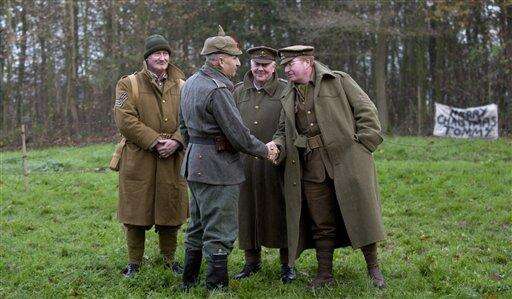
In this photo taken on Nov. 21, 2014, three re-enactors dressed as World War I British soldiers, background, and one dressed as a German soldier, in the foreground, stand on the site of the Bayernwald German WWI trench system in Wijtschate, Belgium as they play out a version of the Christmas Truce for visitors to the site. The trenches were instrumental for German troops during the Battle for Messines Ridge in Belgium. The ridge was fought over for nearly the entire four years of the war. (AP Photo/Virginia Mayo)
The Associated Press
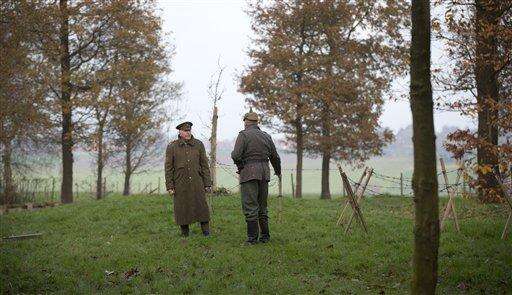
In this photo taken on Nov. 21, 2014, two re-enactors, one dressed as a World War I British soldier, left, and one as a German soldier stand on the site of the Bayernwald German WWI trench system in Wijtschate, Belgium as they play out a version of the Christmas Truce for visitors to the site. The trenches were instrumental for German troops during the bitter Battle for Messines Ridge. The ridge was fought over nearly the entire four years of the war. (AP Photo/Virginia Mayo)
The Associated Press
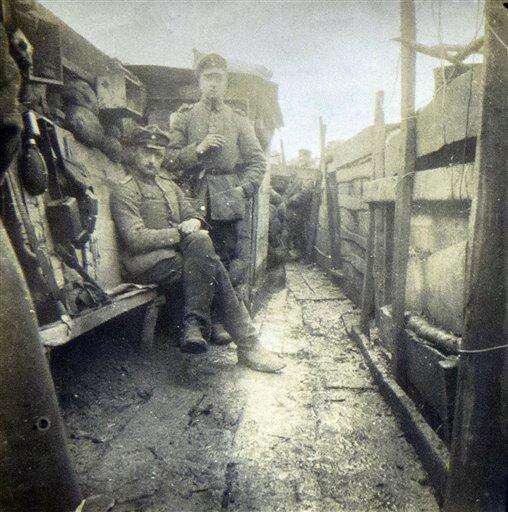
In this photo taken from an image in the collection at In Flanders Fields Museum provided by the family of German soldier Kurt Zehmisch, German World War I soldiers of the 103rd Saxon Regiment sit in their trenches along the Western Front in Warneton, Belgium, during Dec. 1914. Soldiers who had been killing each other by the tens of thousands for months climbed out of their soggy trenches to seek a shred of humanity amid the horrors of World War I. Hands reached out across the divide and in Flanders Fields a century ago, a spontaneous Christmas truce ever so briefly lifted the human spirit. (AP Photo/Virginia Mayo)
The Associated Press

In this photo taken from an image in the collection at In Flanders Fields Museum provided by the family of German soldier Kurt Zehmisch, a German World War I soldier of the 103rd Saxon Regiment wears the hat of a British soldier as he sits in a trench with other German soldiers in Warneton, Belgium, during Dec. 1914. Soldiers who had been killing each other by the tens of thousands for months climbed out of their soggy trenches to seek a shred of humanity amid the horrors of World War I. Hands reached out across the divide and in Flanders Fields a century ago, a spontaneous Christmas truce ever so briefly lifted the human spirit. (AP Photo/Virginia Mayo)
The Associated Press
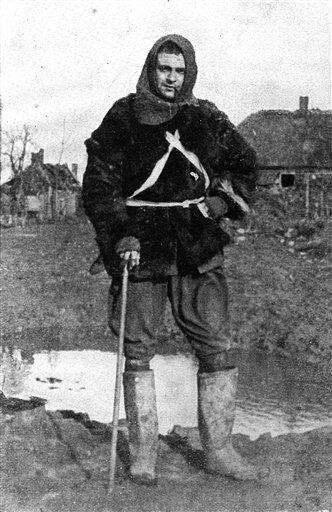
In this photo provided by the Bruce Bairnsfather Society, British World War I soldier and cartoonist Bruce Bairnsfather is seen in Ploegsteert, Belgium in an undated photograph. Bairnsfather was known for his "Old Bill" cartoons, and even more famously for his account of the Christmas Truce at Ploegsteert where he reported that he traded a uniform button with a German soldier. (AP Photo/Bruce Bairnsfather Society)
The Associated Press